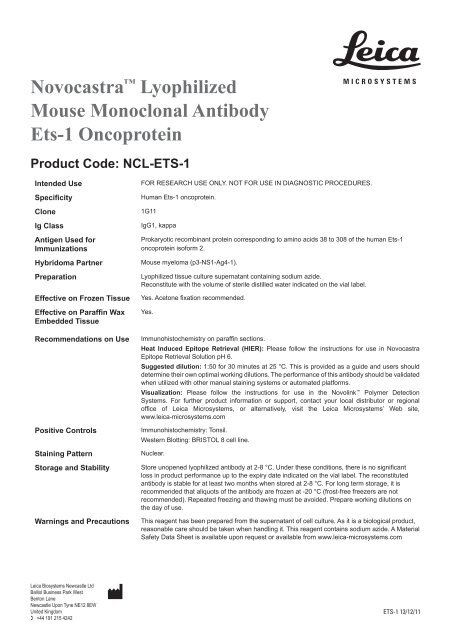Novocastra™ Lyophilized Mouse Monoclonal Antibody Ets-1 ...
Novocastra™ Lyophilized Mouse Monoclonal Antibody Ets-1 ...
Novocastra™ Lyophilized Mouse Monoclonal Antibody Ets-1 ...
Create successful ePaper yourself
Turn your PDF publications into a flip-book with our unique Google optimized e-Paper software.
Novocastra ™ <strong>Lyophilized</strong><br />
<strong>Mouse</strong> <strong>Monoclonal</strong> <strong>Antibody</strong><br />
<strong>Ets</strong>-1 Oncoprotein<br />
Product Code: NCL-ETS-1<br />
Intended Use<br />
Specificity<br />
Clone<br />
Ig Class<br />
Antigen Used for<br />
Immunizations<br />
Hybridoma Partner<br />
Preparation<br />
Leica Biosystems Newcastle Ltd<br />
Balliol Business Park West<br />
Benton Lane<br />
Newcastle Upon Tyne NE12 8EW<br />
United Kingdom<br />
( +44 191 215 4242<br />
FOR RESEARCH USE ONLY. NOT FOR USE IN DIAGNOSTIC PROCEDURES.<br />
Human <strong>Ets</strong>-1 oncoprotein.<br />
1G11<br />
IgG1, kappa<br />
Prokaryotic recombinant protein corresponding to amino acids 38 to 308 of the human <strong>Ets</strong>-1<br />
oncoprotein isoform 2.<br />
<strong>Mouse</strong> myeloma (p3-NS1-Ag4-1).<br />
<strong>Lyophilized</strong> tissue culture supernatant containing sodium azide.<br />
Reconstitute with the volume of sterile distilled water indicated on the vial label.<br />
Effective on Frozen Tissue Yes. Acetone fixation recommended.<br />
Effective on Paraffin Wax<br />
Embedded Tissue<br />
Recommendations on Use<br />
Positive Controls<br />
Staining Pattern<br />
Storage and Stability<br />
Warnings and Precautions<br />
Yes.<br />
Immunohistochemistry on paraffin sections.<br />
Heat Induced Epitope Retrieval (HIER): Please follow the instructions for use in Novocastra<br />
Epitope Retrieval Solution pH 6.<br />
Suggested dilution: 1:50 for 30 minutes at 25 °C. This is provided as a guide and users should<br />
determine their own optimal working dilutions. The performance of this antibody should be validated<br />
when utilized with other manual staining systems or automated platforms.<br />
Visualization: Please follow the instructions for use in the Novolink ™ Polymer Detection<br />
Systems. For further product information or support, contact your local distributor or regional<br />
office of Leica Microsystems, or alternatively, visit the Leica Microsystems’ Web site,<br />
www.leica-microsystems.com<br />
Immunohistochemistry: Tonsil.<br />
Western Blotting: BRISTOL 8 cell line.<br />
Nuclear.<br />
Store unopened lyophilized antibody at 2-8 °C. Under these conditions, there is no significant<br />
loss in product performance up to the expiry date indicated on the vial label. The reconstituted<br />
antibody is stable for at least two months when stored at 2-8 °C. For long term storage, it is<br />
recommended that aliquots of the antibody are frozen at -20 °C (frost-free freezers are not<br />
recommended). Repeated freezing and thawing must be avoided. Prepare working dilutions on<br />
the day of use.<br />
This reagent has been prepared from the supernatant of cell culture. As it is a biological product,<br />
reasonable care should be taken when handling it. This reagent contains sodium azide. A Material<br />
Safety Data Sheet is available upon request or available from www.leica-microsystems.com<br />
ETS-1 13/12/11
General Overview<br />
General References<br />
The proto-oncogene c-<strong>Ets</strong>-1 is a transcription factor known to regulate expression of a number<br />
of genes involved in extracellular matrix remodelling. The processes of tumor invasion and<br />
metastasis are thought to depend on the increased proteolytic activity of the invading tumor<br />
cells which may involve matrix metalloproteinases, cathepsins B and D and plasminogen<br />
activator in the metastatic cascade. <strong>Ets</strong>-1 interacts with the urokinase-type plasminogen activator<br />
gene enhancer and with the promoters of stromelysins-1 and collagenase-1 gene which may<br />
implicate it in this process. In situ hybridisation studies have indicated <strong>Ets</strong>-1 mRNA to be absent<br />
from normal colon mucosa but positive in endothelial cells of stromal capillaries and stromal<br />
fibroblasts, often with increased staining in fibroblasts adjacent to neoplastic cells.<br />
Pande P, Mathur M, Shukla N K, et al.. Journal of Pathology. 189: 40–45 (1999).<br />
Nakayama T, Ito M, Ohtsuru A, et al.. American Journal of Pathology. 149 (6): 1931–1939 (1996).<br />
Bories J C, Willerford D M, Grevin D, et al.. Nature. 377 (6550): 635–638 (1995).<br />
Wernert N, Gilles F, Fafeur V, et al.. Cancer Research. 54: 5683–5688 (1994).<br />
Wernert N, Raes M B, Lassalle P, et al.. American Journal of Pathology. 140 (1): 119–127 (1992).<br />
www.leica-microsystems.com © Leica Microsystems GmbH • HRB 5187 • 95.8147 Rev A

















